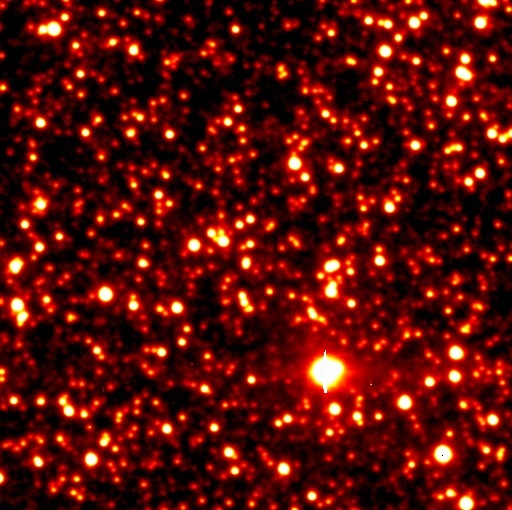
Current research programs being undertaken by the group include:
Having a medium sized optical telescope with plenty of free time gives an important advantage for this work especially as it is well situated for study of the Galactic bulge region where these systems are found. Studies of correlations and delays between optical, X-ray and radio flaring from these sources is providing important information about the physics of accretion discs - the giant engines which convert gravitational energy into radiation.
Our optical observations of the X-ray transients SAX J1808.4-3658 and XTE J0929-314 confirmed the identification of the optical counterparts and detected orbital period modulations in both. These systems are believed to contain neutron stars spun up by accretion and are believed to be the progenitors of the millisecond radio pulsars. Our multi-band (BVRI) photometry of these systems has recently uncovered evidence for a variable long wavelength excess (above accretion disc thermal emission) which may be due to synchrotron radiation from high velocity matter being expelled from the system via bipolar jets.

When a foreground star passes in front of a background (source) star the observed intensity increases, sometimes by over 100 times. The foreground star is called the lens because its gravitational field bends the light from the source focussing more of it on the observer. Because stars move relative to each other this leads to a bell-shaped light curve with a duration of weeks to months. The PLANET collaboration uses telescopes in Chile, South Africa, Western Australia and Tasmania to monitor the light curve of selected microlensing events more or less continuously every 1-2 hours. If the lensing object has planets there will be short duration anomalies (deviations from the "normal" bell- shape) in the light curve. Detailed mathematical modelling of the light curve can provide information about the mass and orbital radius of the planet.
The principal advantage of microlensing is that it is most sensitive to planets at a few AU from their parent star. Hence, unlike the radial velocity and transit methods of exo-planet searches (which are most sensitive to "hot Jupiters") it probes for planets similar to those in our own solar system. Recently we contributed to the discovery of a Jupiter-mass planet in the OGLE 2005-BLG-071 event. This discovery demonstrated that even Earth-mass planets can be detected by microlensing.
When the lenshas a binary stellar companion the light curve becomes very complex
with sudden episodes of very rapid change in apparent brightness. Study
of these rapid changes (called "caustic crossings") provides a powerful tool for
studying limb darkening in the source star i.e. the distribution of light across the
stellar disc. This important property is poorly known for stars other
than the sun. Many of the physical parameters of the binary system can
also be deduced. During some caustic crossing events we use one of the ESO
VLT 10m telescopes to conduct spatially resolved spectroscopy of source stars.
This has enabled us to measure the atmospheric structure of stars in
the Galactic Bulge - something which has not previously been done for
stars other than the sun. The huge magnification seen in some events
will make it possible to do medium and sometimes even high resolution
spectroscopy of stars in the Bulge with our own spectrograph - making
it equivalent, for a few hours, to a 5 or 10 m telescope!
For more details of our microlensing observations see the
PLANET homepage.
Kinematic Analysis of the HR Supercluster: The Horologium-Reticulum Supercluster (HRS) is one of the most massive galaxy concentrations in the Southern sky. Dr Johnston-Hollitt is working with a team of researchers from the US and Australia to study the multi-wavelength properties of the HRS. In particular, under a collaborative research effort involving Fleenor, Rose & Christiansen (University of North Carolina), Hunstead (University of Sydney) & Johnston-Hollitt (University of Tasmania) we are seeking to evaluate the kinematics of the central part of the HRS around the galaxy clusters A3125/A3128. We have an extensive existing multi-frequency dataset for this region (optical, radio and X-ray) and potential student projects include: compuation of the radio luminosity function in the region and analysis of the HRS structure through use of radial velocity measurements. Students could also participate in new optical (spectroscopic) or radio (ATCA) observation of the region as part of the on-going effort.
Observing Merging Southern Clusters of Galaxies: Large-scale structure in the Universe is thought to be assembled via accretion and merging processes between clusters of galaxies. In some cases these mergers appear violent and create shock waves on Mpc scales. These shocks are thought to be responsible for the enigmatic phenomena of Mpc-scaled "radio relics" which are seen in several clusters (see the picture of A3667 to the right). In collaboration with Prof R. W. Hunstead (Sydney) and Dr Corina Vogt (ASTRON) we are studying a sample of Southern clusters containing these radio relics to try to better understand their origin and generation. This project would involved multi-frequency radio observations of several southern clusters using the ATCA and associated analysis